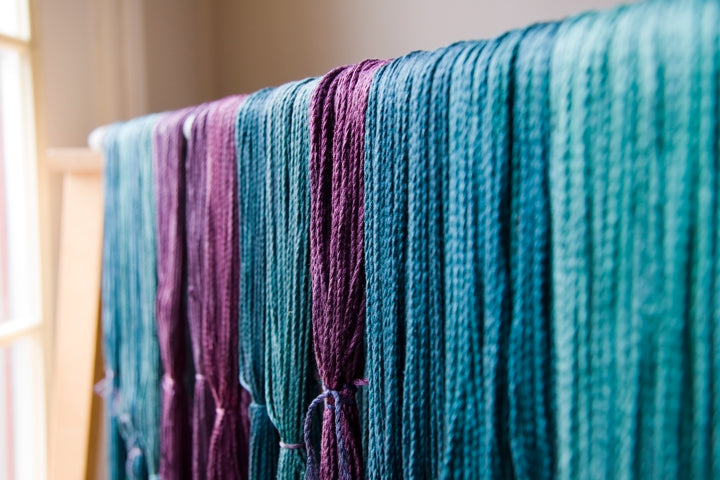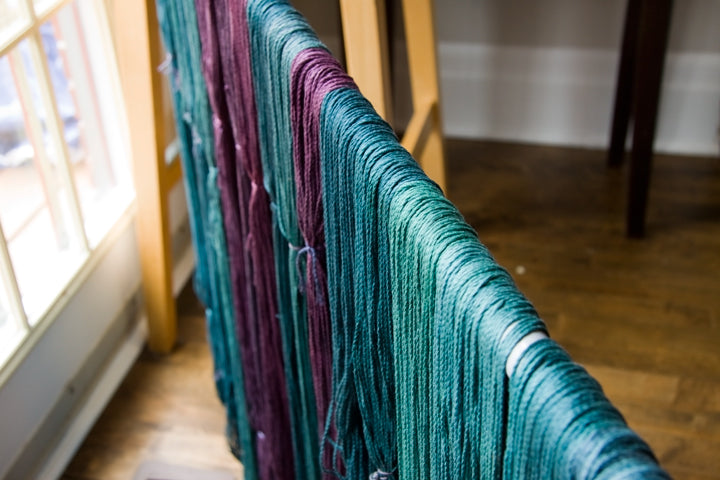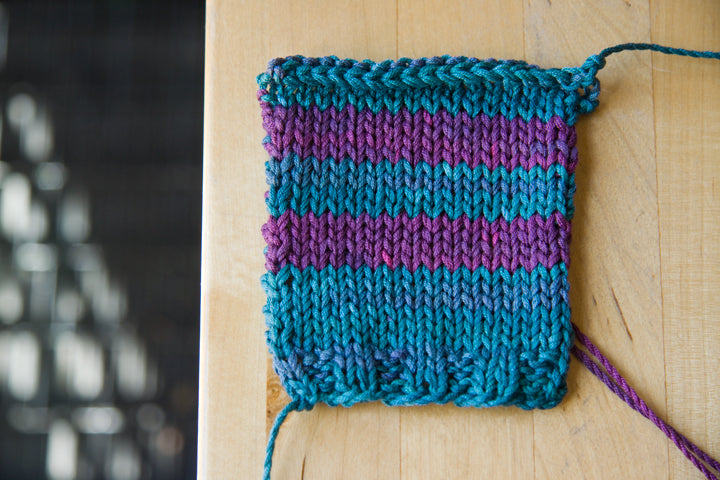The final instalment of my little overdyeing project. I don't have pictures of all the simmering and rinsing. Just too much steam and water for me to think of getting the camera out.
The process:
- 18 Balls of yarn turned into skeins (by far the hardest part, almost made me quit) and soaked in warm water with a touch of laundry soap. I'm sure Synthrapol would be better, but we're not too fancy round these parts.
- Large enamel canning pot promoted to dyeing, congratulations Pot.
- Soaked yarn drained and rinsed. Put in Pot. Just covered with water.
- Careful calculations made: 18 balls at 50 grams is 900 grams, 454 grams to the lb, so have almost exactly 2 lbs. Carefully measure dry dye by dumping about half of it into clean spaghetti sauce jar. Boiling water dribbled in. In retrospect, should always add dry powder to wet so the powder doesn't poof up. I vaguely remember something like this from etching class, do as you ought to, add acid to water" (the "ought to" pronounced "otter" to rhyme with "water"). I think the same would apply here: add the stronger thing to the water to avoid splashback or poofing. No worries though, I was very safe; used precaution of squinting while stirring dye concoction.
- Dribbled dye concentrate on top of yarn.
- Made second batch of concentrate, in second colour, dribbled it over yarn.
- Brought to simmer.
- Allowed to simmer for 25 minutes, occasionally poking at it with old chopstick.
- Read instructions properly, says don't allow temperature to go above 185 if dyeing silk. Oh crap.
- Google "what is 185 in celsius"?
- Have overcooked silk for 25 minutes, but don't know why it matters. Turn heat down.
- Dye bath still not exhausted. Label on dye says to add white vinegar if this happens. Don't have white vinegar. Add white wine vinegar. Very smelly. Probably not acidic enough.
- Cook 15 more minutes.
- Let cool for several hours. Actually forgot about it and watched Netflix.
- Carefully walk pot down to basement utility sink, visualizing what would happen if I spilled the whole thing on carpet.
- Drain and rinse. Surprisingly, all the tangles fall away in the rinsing.
- Squeeze out extra water in towels.
- Set aside the now-purple yarn, and re-dyed the teal and blue with only the lime dye, wanted less blue more green. Was more careful with the heat, and added concentrated lemon juice from the beginning. Have no idea if there's enough citric acid in concentrated lemon juice to help with the chemistry, but figure it can't hurt.
- Drain and rinse etc.
- Hang everything to dry on broom handle. Congratulations Broom Handle.
- Admire handywork.


The outcome:
- The pink took the dark teal dye beautifully (as I hoped), and turned a satisfying crushed berry colour.
- The dark teal yarn didn't take much of the dark teal dye (as I expected), but is now more mottled.
- The light blue yarn took the dark teal dye nicely, quite mottled (as I wanted), and also, strangely, picked up some pink from the pink yarn, so now has spots of purple.
- The teal and blue yarn picked up the lime quite nicely in the second try, and now have a satisfying range of blue-green and teal.
- Have little blank spots on skeins from tying them too tightly, like tie-dye. But I like the way it looks knitted up, the blank spots make nice random flecks.
What I Would Do Differently Next Time
- Do a bath with only the dark skeins with a darker dye. The two colour of teals became more similar than I wanted.
- Get citric acid. Vinegar really does smell while it's cooking.
- Use contrasting, non-dyeable twine to tie the skeins.
- Trick the children into winding the skeins for me.
What I Would Do the Same
- Like the haphazard hybrid of kettle-dye/hand-painted, so would do the low-water, dribble on the dye, "technique" again.
- All in one pot. Like the wabi-sabi-ness of the yarn colours bleeding into each other.

"
